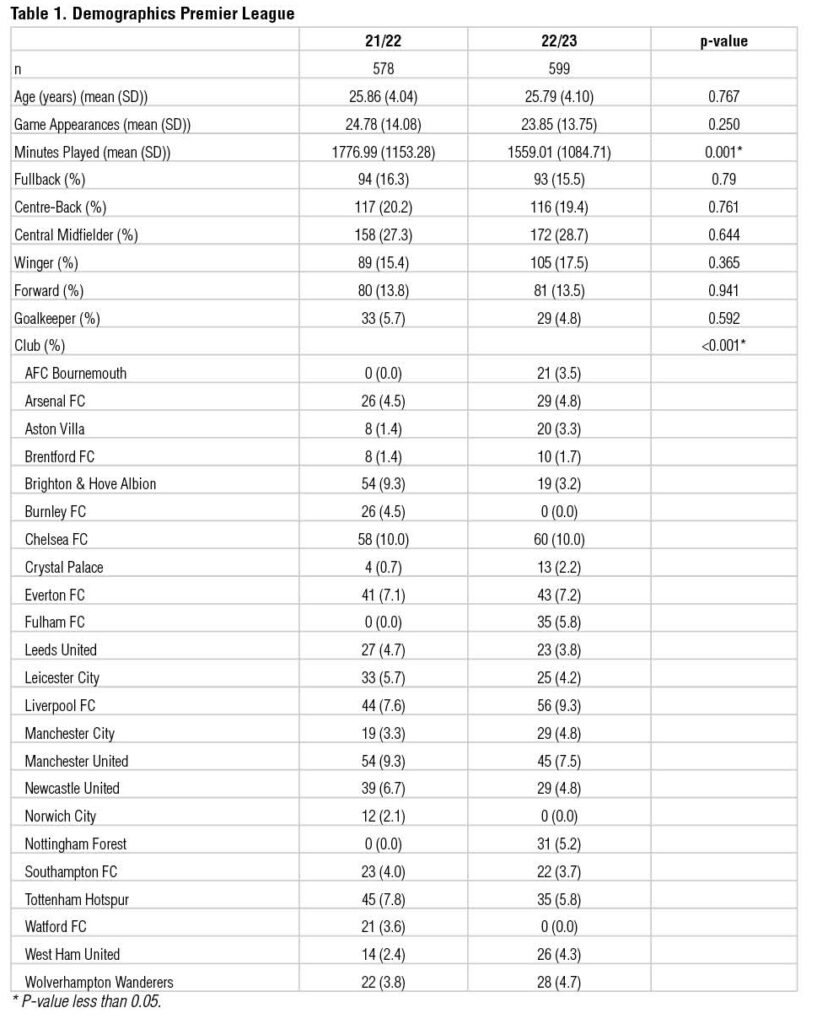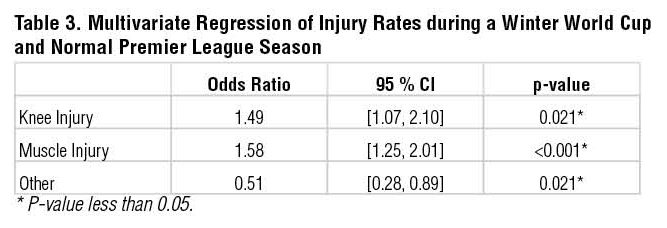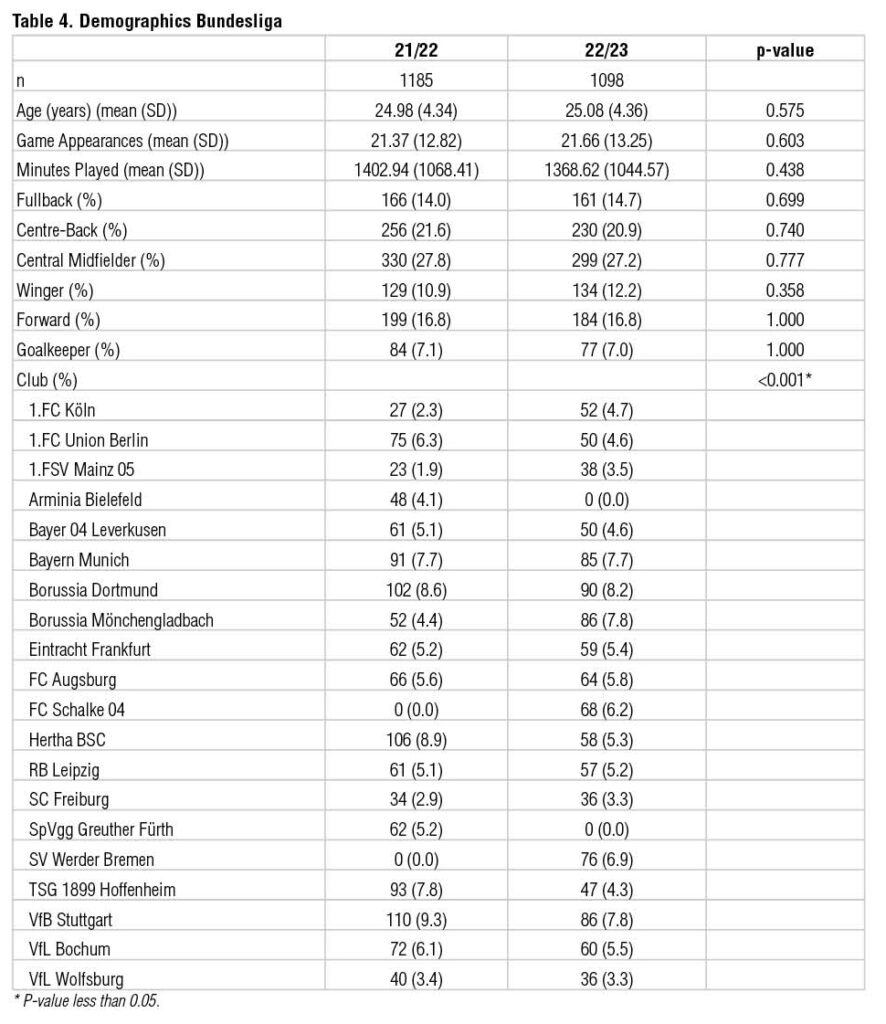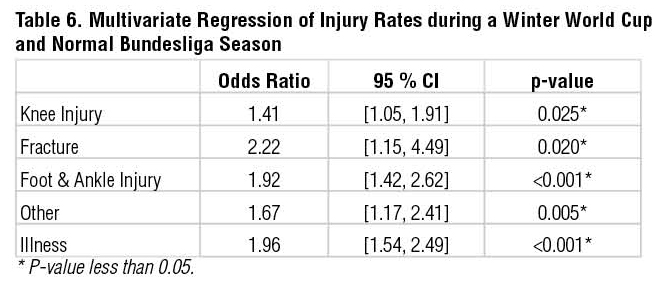Ibraheem Qureshi, BS1; Shawn Rahman, DO2; Brian G. Webb, MD2
1New York Institute of Technology College of Osteopathic Medicine, 101 Northern Blvd, Glen Head, NY 11545
2JPS Health Network, 1500 S Main St, Fort Worth, TX 76104
DOI: 10.70709/cmbqydg4rx
Abstract
Background
For the first time in its history, the FIFA World Cup was held in the winter instead of its traditional summer time slot. This time slot interrupted European domestic leagues that run through the winter and forced them to congest matches, schedule a month-long break, and prolong their season. The purpose of this study was to compare the injury rates between a normal uninterrupted season and the 2022/2023 World Cup interrupted season. We hypothesized that the 2022/2023 season would have an increase in muscle injuries, games missed, and days spent injured.
Methods
This study retrospectively looked at Premier League and Bundesliga players who sustained injuries during the 2021/2022 and 2022/2023 season. Injured players were identified on the publicly available online database Transfermarkt. Information regarding the number and characteristics of the injuries was extracted and categorized according to each season. To evaluate the potential complications arising from these injuries, multivariate regression models were employed. The models adjusted for age, minutes played, and appearances.
Results
There were significantly increased odds of muscle injuries sustained by players during the World Cup season in the Premier League (OR:1.58; 95% CI [1.25,2.01];p<0.001) and foot and ankle injuries in the Bundesliga (OR:2.22; 95% CI [1.42,2.62];p<0.001). Both leagues saw increased odds of knee injuries (OR:1.49; 95% CI [1.07,2.10];p=0.021) (OR:1.41; 95% CI [1.05,1.91];p=0.025). There was a significant decrease in minutes played by injured players (p=0.001) in the Premier league and injured Bundesliga players saw a significant increase in days spent injured from 26.23 days to 30.37 days (p=0.033).
Conclusions
There was a significant increase in the rate of injuries sustained by players in English and German leagues during the World Cup Season compared to a normal season with increased odds of injuries such as muscle injuries and knee injuries. A midseason slot may not be the best time to schedule a World Cup.
Keywords: Muscle, injury, soccer, premier league, bundesliga
Level Of Evidence: Level III Descriptive Epidemiology Study
Introduction
The FIFA World Cup is traditionally held every 4 years in June and July dating back to 1930. For the first time in its history, it was moved from its summer schedule to a winter schedule due to intense summers in Qatar, the host nation for the 2022 World Cup. Temperatures in Qatar consistently reach up to 50 degrees Celsius (122 degrees Fahrenheit) increasing the risk of exertional heat related illness and making a soccer tournament in this climate less than ideal1,2. Athletes are highly monitored for injuries due to their negative consequences such as reduced performance, financial impacts, and long term health of players3–6. With this in mind, the tournament schedule was shifted to a cooler November and December slot.
Following the world cup, Fédération Internationale des Associations de Footballeurs Professionnels (FIFPRO) published a report based on player surveys demonstrating clear and pressing danger to the physical and mental health of players due to match schedule congestions and the lack of allocated rest time before, during, and after the tournament7. The World Cup compressed 64 matches in 29 days putting an intense physical demand on players7. According to the FIFPRO 2022 report, 50% of players felt they had enough time to prepare for the tournament, 11% of players favored the November and December timing, and 53% of players reported or felt more likely to suffer an injury due to the congested season7.
The purpose of this study was to compare the injury rates between normal uninterrupted English Premier League and German Bundesliga seasons and their respective 2022/2023 World Cup interrupted seasons to analyze the complete impact the 2022 World Cup had on athletes. We aimed to compare the rates of different types of injuries, days spent injured, and appearances in all injured players between the two seasons. We hypothesized that the 2022/2023 season would have an increase in muscle injuries, games missed, and days spent injured.
Methods
Study Design
This retrospective observational study analyzed injury rates, games missed, and minutes played among professional soccer players in the English Premier League and German Bundesliga during the 2021/2022 and 2022/2023 seasons. The primary objective was to assess the impact of the 2022 FIFA World Cup, which interrupted the domestic league schedule, on player injury patterns. Injury was defined as any event that resulted in a player’s forced absence from matches or training, excluding absences due to personal leave, suspension, or non-injury-related reasons. Illnesses, including COVID-19, were included because they resulted in involuntary removal from team participation and can significantly disrupt player fitness, aligning with our definition of injury as any forced absence unrelated to personal choice or disciplinary action.
Study Population and Sample Size
The study population included players rostered on teams in the English Premier League and German Bundesliga during the 2021/2022 and 2022/2023 seasons. Injury data were sourced from Transfermarkt (https://www.transfermarkt.com/), a publicly available database frequently cited in epidemiological research on professional soccer8,9. Transfermarkt provides detailed demographic and injury history information for professional soccer players.
The inclusion criteria for this study consisted of players competing in the Premier League or Bundesliga during the specified 2021/2022 and 2022/2023 seasons, and players with recorded injuries in the Transfermarkt database. Players from lower divisions or leagues outside the Premier League and Bundesliga were excluded.
A total of 1,763 injuries were recorded during the 2021/2022 season, and 1,697 injuries during the 2022/2023 season were included in the analysis.
Study Measures
The primary outcomes of this study included injury rates, defined as the total number of injuries sustained by players during each season; games missed, representing the total number of games players were unavailable due to injuries in each season; and minutes played, which reflected the total playing time recorded for injured players during each season. Additionally, a derived variable, multiple injuries, was defined as instances where players sustained reinjuries or new injuries within the same season, regardless of anatomical location.
Statistical Analysis
All statistical analyses were conducted using R (version 4.1.2; R Foundation for Statistical Computing, Vienna, Austria), with the worldfootballR package utilized for data extraction and organization. Continuous variables, such as games missed and minutes played, were analyzed using t-tests, while categorical variables, such as the presence of multiple injuries, were assessed using chi-squared tests.
Multivariate logistic regression models were used to evaluate the association between the World Cup-interrupted 2022/2023 season and injury outcomes. These models adjusted for potential confounding variables, including player age, total minutes played during the season, and total appearances. Odds ratios (OR) with corresponding 95% confidence intervals (CI) were calculated for each outcome. Statistical significance was defined as a p-value of less than 0.05.
Results were stratified by injury type, such as muscle and knee injuries, and player position, including forwards, defenders, and goalkeepers. Summary statistics, including frequencies and means with standard deviations, were calculated for demographic and injury variables.
Results
The Transfermarkt database included an overall total of 1,697 injuries during the interrupted 2022/2023 World Cup season versus 1,763 during the prior 2021/2022 season for the English Premier League and German Bundesliga. The Premier League had 599 injuries amongst 269 different players in the World Cup season and 578 injuries amongst 264 different players in the prior season. There were a total of 840 and 805 players in those two seasons respectively. Bundesliga athletes included 1098 injuries amongst 402 different in the World Cup season and 1185 injuries amongst 454 different in the prior season. There were a total of 645 and 649 players in those two seasons respectively. During the interrupted World Cup Season, Premier League athletes had significantly increased odds of obtaining muscle injuries (OR: 1.58; 95% CI: [1.25, 2.01]; p<0.001) and knee injuries (OR: 1.49; 95% CI: [1.07, 2.10]; p=0.021) after adjusting for confounding variables and had significantly decreased amount of COVID-19 infections (p<0.001) and other miscellaneous injuries (p=0.028) (Table 3 & Table 2). Bundesliga athletes during the World Cup season had significantly increased odds of knee injuries (OR: 1.41; 95% CI: [1.05, 1.91]; p=0.025), foot and ankle injuries (OR: 1.92; 95% CI: [1.42, 2.62]; p<0.001), obtaining fractures (OR: 2.22; 95% CI: [1.15, 4.49]; p=0.020), other injuries (OR: 1.67; 95% CI: [1.17, 2.41]; p=0.005), and getting ill (OR: 1.96; 95% CI: [1.54, 2.49]; p<0.001) after adjusting for confounding variables (Table 6). The Bundesliga also had a significantly decreased number of COVID-19 infections (p<0.001) (Table 5). Injured Bundesliga players saw a significant increase in days spent injured from 26.23 days in the 2021/2022 season to 30.37 in the 2022/2023 season (p=0.033).
In the Premier League, demographics of injured athletes showed significant differences in minutes played (p=0.001) and injuries per club (p<0.001) in the 2022/2023 season (Table 1). Injured athletes played significantly fewer minutes in the 2022/2023 season. Excluding teams that did not play in the Premier League in both seasons due to division promotion and relegation, Arsenal FC, Aston Villa, Brentford FC, Crystal Palace, Everton FC, Liverpool FC, Manchester City, West Ham United, and Wolverhampton Wanderers saw an increase in their overall proportion of injuries from the 2021/2022 season to the 2022/2023 season.
Demographics of athletes in Bundesliga showed significant differences in injuries per club (p<0.001) in the 2022/2023 season (Table 4). Barring teams that did not play in the Bundesliga in both seasons due to division promotion and relegation, 1.FC Koln, 1.FSV Mainz 05, Borussia Mönchengladbach, Eintracht Frankfurt, FC Augsburg, RB Leipzig, and SC Freiburg saw an increase in proportion of injuries from the 2021/2022 season to the 2022/2023 season.
Discussion
Understanding the effect of a World Cup interrupting the middle of the European domestic league soccer season on injuries is important for potential risks athletes face and future scheduling of World Cups. The most important finding of this study was that a World Cup interrupted season had significantly increased rates of knee injuries which was found in both the English Premier league and Bundesliga. Athletes had increased odds of sustaining muscle injuries in the Premier League and fractures, foot and ankle injuries, other miscellaneous injuries, and illnesses in the Bundesliga league during a World Cup interrupted season.
The link between match congestion and muscle injury has previously been studied in athletes in multiple studies10–12. Bengtsson et al found players and teams involved in European competitions such as the Union of European Football Associations (UEFA) Champions League had fewer days of recovery and increased muscle injuries in league matches10. Pinheiro et al. found prolonged exposure to match congestion lead to higher risk of muscle injuries in a cohort of 13 professional soccer players11. Wollin et al. found reduced post match recovery days led to decreased hamstring strength and range of motion in a cohort of 15 professional soccer players12. While not many studies have been published in regards to the 2022 World Cup, FIFPro published a report citing a majority of injuries in the 2022/2023 season reported by teams in five leagues were soft tissue injuries13. These results correlate to our findings of higher rates and proportions of muscle injuries in a World Cup interrupted season. This highlights the need for better injury management and prevention strategies especially in the context of seasons with increased match frequency and physical demand.
In the current literature, some studies have looked at the impact the winter World Cup had on player performance and league scheduling. In French Ligue 1 teams, there was a 23% increase in total injuries observed, specifically in knee, ankle, and muscle injuries during the Winter World Cup season compared to the normal prior season14. Among muscle injuries, hamstring and calf injuries saw a significant increase14. Branquinho et al. highlighted a stark reduction in the turnaround between the conclusion of domestic leagues and the commencement of international tournaments during the 2022 winter World Cup, shrinking from 4-5 weeks to 1 week for teams to prepare15. Furthermore, there was a congestion of matches played in the first four months of the season preceding the World Cup. This was notably evident in the UEFA Champions League group stage, which was condensed from its 3-month span to 8 weeks15. Compared to the 2018 World Cup, players in the 2022 World Cup were found to have covered 3% more distance and 16-19% more distance at higher intensities16. The increase in performance and exertion may be attributed to the recent permanent rule change which increased the number of substitutions per game and the increase in stoppage time which was trialed during this World Cup16. These two areas require further research on how these changes affect player exertion and injuries.
Our study found a significant increase in knee injuries, fractures, and muscle injuries. Additionally, it’s important to highlight that during the comparison of the two seasons, there was a notably higher incidence of COVID-19 infections in the 2021/2022 season as the COVID-19 pandemic was still prevalent compared to 2022/2023. Excluding these cases, the overall number and rate of injuries would be reduced compared to the 2022/2023 season, increasing the significance of our findings. The 2021/2022 and 2022/2023 season would have 398 and 30 fewer injuries, respectively. While our study included all types of knee injuries, other studies have mostly looked specifically at anterior cruciate ligaments (ACL) injuries trends in soccer leagues17,18. This makes comparing the incidence of knee injuries in our study difficult and warrants specific future studies to be done to analyze injuries such as ACL tears in elite soccer players in different first division soccer leagues. When assessing the rate of fractures in previous years, the Bundesliga between 2009 and 2017 seasons found an incidence of 357 fractures with an average of 47.6 fractures per season, which was higher than the number of fractures found in the Bundesliga in either the 2021/2022 or 2022/2023 seasons9. However, Schiffner et al. found a decreasing trend in fractures while our study found a significant increase in fractures9. This presents another area of future study to analyze the trends and epidemiology of fractures in the Bundesliga and other European soccer leagues over a larger and more recent time frame. Resting players is a practice in sports to prevent muscle injuries and keep players healthy. Soccer coaches perceive load management as worthwhile to maximize fitness19. However, not many studies have been done to determine the significance of load management with only one done on elite youth soccer players finding no significant impact of load management20. Players were rested at low rates in both seasons studied in each league. The usage of rest may be an area of future study that may be applicable in preventing the significant increase in muscle injuries seen during the World Cup season.
Our study is not without limitations. Data collection from public databases has inherent challenges with accuracy and reliability of user reported data. As a result, our study may be inflating the incidence of certain injury types due to non-specific injury reporting. Additionally, without access to team data, the true number of injuries could not be obtained. The lack of comprehensive injury details, such as recovery time, specific injury mechanisms, specific types of fractures, also might hinder a comprehensive understanding of the injury landscape. Details regarding time between matches and other specific aspects of match congestion were not available, which limits the full understanding of the underlying factors driving these injury trends. As a result, we were unable to assess match frequency, training load, or whether injuries were new or recurrent, restricting our ability to determine whether the observed injury patterns were primarily due to schedule congestion, inadequate recovery, or changes in training intensity. Also, it is important to note the Premier League and Bundesliga differ in structure. The former has 20 teams playing 38 games, while the latter has 18 teams playing 34 games. Thus, the percentage of injuries per league is more accurate than total injuries recorded. Despite these constraints, the study still holds value in offering insights into injury trends, but researchers must exercise caution and explore alternative data sources to supplement and validate the findings.
Conclusion
There was a significant difference in injuries sustained and complications by athletes that played during a normal season and a World Cup interrupted season. Athletes in the 2022/2023 season had increased risk of muscle injuries, fractures, knee injuries, and spending more time injured. Scheduling a World Cup in the middle of a season should only be done after thorough consideration of the possible effects it has on player fitness and the risk and severity of injuries that it can cause. FIFA should keep this injury risk profile in mind when scheduling future World Cups.






References
- Matzarakis A, Fröhlich D. Sport events and climate for visitors–the case of FIFA World Cup in Qatar 2022. Int J Biometeorol. 2015;59(4):481-486. doi:10.1007/s00484-014-0886-5
- Nichols AW. Heat-related illness in sports and exercise. Curr Rev Musculoskelet Med. 2014;7(4):355-365. doi:10.1007/s12178-014-9240-0
- Eirale C, Tol JL, Farooq A, Smiley F, Chalabi H. Low injury rate strongly correlates with team success in Qatari professional football. Br J Sports Med. 2013;47(12):807-808. doi:10.1136/bjsports-2012-091040
- Hägglund M, Waldén M, Magnusson H, Kristenson K, Bengtsson H, Ekstrand J. Injuries affect team performance negatively in professional football: an 11-year follow-up of the UEFA Champions League injury study. Br J Sports Med. 2013;47(12):738-742. doi:10.1136/bjsports-2013-092215
- Ekstrand J. Keeping your top players on the pitch: the key to football medicine at a professional level. Br J Sports Med. 2013;47(12):723. doi:10.1136/bjsports-2013-092771
- Drawer S, Fuller CW. Propensity for osteoarthritis and lower limb joint pain in retired professional soccer players. Br J Sports Med. 2001;35(6):402-408. doi:10.1136/bjsm.35.6.402
- FIFPRO. Fifpro player Workload Monitoring. FIFA World Cup 2022 Post Tournament Review & Player Survey. Published online March 9, 2023.
- Prieto-Lage I, Louzao-Neira I, Argibay-González JC, Gutiérrez-Santiago A. Injury patterns of professional footballers in the Spanish first division during the 2017-2018 seasons. Physiol Behav. 2020;224:113052. doi:10.1016/j.physbeh.2020.113052
- Schiffner E, Latz D, Grassmann JP, et al. Fractures in German elite male soccer players. J Sports Med Phys Fitness. 2019;59(1):110-115. doi:10.23736/S0022-4707.17.07901-4
- Bengtsson H, Ekstrand J, Hägglund M. Muscle injury rates in professional football increase with fixture congestion: an 11-year follow-up of the UEFA Champions League injury study. Br J Sports Med. 2013;47(12):743-747. doi:10.1136/bjsports-2013-092383
- Pinheiro GS, Quintão RC, Claudino JG, Carling C, Lames M, Couto BP. High rate of muscle injury despite no changes in physical, physiological and psychophysiological parameters in a professional football team during a long-congested fixture period. Res Sports Med Print. 2023;31(6):744-755. doi:10.1080/15438627.2022.2038159
- Wollin M, Thorborg K, Pizzari T. Monitoring the effect of football match congestion on hamstring strength and lower limb flexibility: Potential for secondary injury prevention? Phys Ther Sport Off J Assoc Chart Physiother Sports Med. 2018;29:14-18. doi:10.1016/j.ptsp.2017.09.001
- FIFPro. Extreme Calendar Congestion: The Adverse Effects on Player Health and Wellbeing. Accessed July 26, 2023. https://fifpro.org/media/qa5pkwep/fifpro_pwm2023_final.pdf.
- Orhant E, Chapellier JF, Carling C. The impact of a mid-season FIFA World CupTM on injury occurrence and patterns in French professional soccer clubs. Res Sports Med Print. Published online March 6, 2024:1-10. doi:10.1080/15438627.2024.2326517
- Branquinho L, Forte P, Thomatieli-Santos RV, et al. Perspectives on Player Performance during FIFA World Cup Qatar 2022: A Brief Report. Sports Basel Switz. 2023;11(9):174. doi:10.3390/sports11090174
- Bradley PS. “Setting the Benchmark” Part 2: Contextualising the Physical Demands of Teams in the FIFA World Cup Qatar 2022. Biol Sport. 2024;41(1):271-278. doi:10.5114/biolsport.2024.131091
- Nitta CT, Baldan AR, Costa LPDB, Cohen M, Pagura JR, Arliani GG. EPIDEMIOLOGY OF ANTERIOR CRUCIATE LIGAMENT INJURY IN SOCCER PLAYERS IN THE BRAZILIAN CHAMPIONSHIP. Acta Ortop Bras. 2021;29(1):45-48. doi:10.1590/1413-785220212901235225
- Requejo-Herrero P, Pineda-Galan C, Medina-Porqueres I. Anterior cruciate ligament ruptures in Spanish soccer first division: An epidemiological retrospective study. The Knee. 2023;41:48-57. doi:10.1016/j.knee.2022.11.014
- Weston M. Training load monitoring in elite English soccer: a comparison of practices and perceptions between coaches and practitioners. Sci Med Footb. 2018;2(3):216-224. doi:10.1080/24733938.2018.1427883
- Torstein Dalen-Lorentsen, John Bjørneboe, Benjamin Clarsen, Markus Vagle, Morten Wang Fagerland, Thor Einar Andersen. Does load management using the acute:chronic workload ratio prevent health problems? A cluster randomised trial of 482 elite youth footballers of both sexes. Br J Sports Med. 2021;55(2):108. doi:10.1136/bjsports-2020-103003


